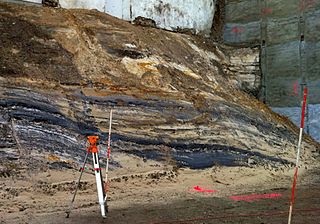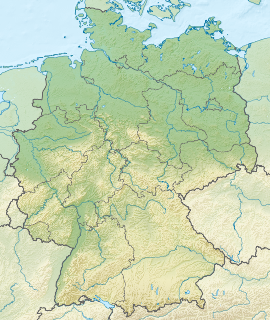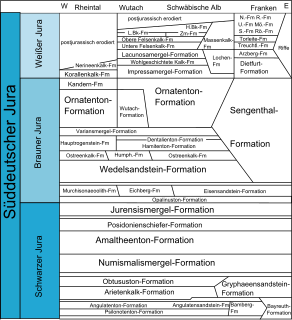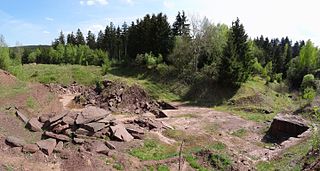 W
WThe Aachen Formation is a Late Cretaceous geologic formation in the southern Netherlands and northeastern Belgium and adjacent Germany.
 W
WThe Ahbach Formation is a geologic formation in Germany. It preserves fossils dating back to the Middle Devonian period.
 W
WThe Allgäu Formation is a geologic formation in Austria. It preserves fossils dating back to the Hettangian to Sinemurian stages of the Early Jurassic period, or Raricostatum to Obtusum in the regional stratigraphy. Initially and formally defined by Jacobshagen (1965). The Allgäu Formation is formerly known as spotted marls (Lias-Fleckenmergel) and spotted marly limestones (Fleckenkalk). The formation is represented by dark-grey bioturbated limestones and marlstone interbeds. It represents basinal hemipelagic facies common in Alpine Tethys regions of Alps, Carpathians and other mountain ranges. Several horizons of the formation are particularly rich in ammonite fauna.
 W
WThe Ansbachersandstein is a Late Triassic (Carnian) geologic formation in Germany. Indeterminate fossil ornithischian tracks have been reported from the formation.
 W
WThe Benkersandstein is a geologic formation in Germany. It preserves fossils dating back to the Late Triassic (Carnian) period. Fossil theropod tracks have been reported from the formation.
 W
WThe Berger Rücken is a geological formation that extends along the northeast edge of Frankfurt am Main. Parts of the Bergen Ridge belong to the Frankfurt Green Belt and its Natural Springs Hiking Trail. The southern side of the Bergen Ridge, once covered with vineyards, is now home to one of Frankfurt's premier residential districts, Berger Hang.
 W
WThe Black Jurassic or Black Jura in earth history refers to the lowest of the three lithostratigraphic units of the South German Jurassic, the latter being understood not as a geographical, but a geological term in the sense of a lithostratigraphic super group. Formerly and even occasionally today in the popular scientific literature, this term is equated to the chronostratigraphic series of the Lower Jurassic. This is however not quite correct, because the Black Jura does not exactly coincide with the chronostratigraphic boundaries of the Lower Jurassic. In addition, the term lias, which was formerly frequently used as a synonym, should no longer be used in connexion with the South German Jurassic. Instead, the term lias, or North German Lias, should be reserved for the roughly equivalent lithostratigraphic unit in the North German Jurassic. The deposition of the Black Jurassic took place about 199 to 175 million years ago. The Black Jurassic follows the lithostratigraphic unit of the Keuper and is superimposed on the lithostratigraphic group of the Brown Jurassic.
 W
WThe Blasensandstein is a Carnian geologic member in Bavaria, Germany. It is part of the Hassberge Formation. Fossil theropod tracks have been reported from the formation.
 W
WThe Brown Jurassic or Brown Jura in earth history refers to the middle of the three lithostratigraphic units of the South German Jurassic, the latter being understood not as a geographical, but a geological term in the sense of a lithostratigraphic super group. Formerly and even occasionally today in the popular scientific literature, this term is equated to the chronostratigraphic series of the Middle Jurassic. This is however not quite correct, because the Brown Jura does not exactly coincide with the chronostratigraphic boundaries of the Middle Jurassic. In addition, the term Dogger, which was formerly frequently used as a synonym should no longer be used in connexion with the South German Jurassic. Instead the term "Dogger" should be reserved for the roughly equivalent lithostratigraphic unit in the North German Jurassic. The Brown Jurassic was deposited about 175-161 million years ago. The Brown Jurassic follows the lithostratigraphic unit of the Black Jurassic and is superimposed on the lithostratigraphic group of the White Jurassic.
 W
WThe Bückeberg Formation is a geologic formation and Lagerstätte in Germany. It preserves fossils dating back to the Berriasian of the Cretaceous period. The Bückeberg Formation has previously been considered to constitute the "German Wealden" in reference to its similarity to the Wealden Group in the United Kingdom. More recently it has been considered a group, containing the Isterberg and Deister Formations. The plesiosaur Brancasaurus, and an indeterminate ankylosaur referred to Hylaeosaurus are known from the formation.
 W
WThe Ciechocinek Formation, formerly known in Germany as the Green Series is a Jurassic geologic formation that extends across the Baltic coast, from Grimmen, Germany, to Nida, Lithuania, with its major sequence on Poland and a few boreholes on Kaliningrad. Dinosaur remains are among the fossils that have been recovered from the formation, including the Thyreoporan Emausaurus and others which have not yet been allocated to a specific genus. The layers assigned to the formation are a group of sediments that differ from the those of the Posidonia Shale and other Toarcian formations of Europe. Most of the sediments of the Polish realm come from deltaic, fluvial and marine deposits. In the Polish realm there is also an abundance of siderite, attributed to mixed saline and marine action, with the rounding off of some due to transport by freshwater or sea currents. Fossil-rich upper Liassic carbonate concretions are occasionally found as glacial erratic boulders. Erratic boulders of so-called Grätensandstein can be dated by their ammonite content as lower Toarcian sandstones with concentrations of fish remains and missing ammonites known from gravel pits south of the Grimmen Anticline in Western Pomerania. Those strata are the most important level of the Green Series Formation. The sandstones are carbonate-cemented concretions originating from fine sand lenses generated in channel fills cut into the clay. Most of the upper Liassic erratic boulders may have originated from the Grimmen anticline. Its main equivalents are the Posidonia Shale, upper part of the Rydeback Member, Rya Formation, the Fjerritslev Formation, the Bagå Formation (Bornholm) or the Lava Formation (Lithuania). There are also coeval abandoned informal units in Poland: Gryfice Beds, Lower Łysiec beds, or the "Estheria series".
 W
WThe Dactyliocerassandstein Formation is a Lower Jurassic geologic formation primarily located in Regensburg, Germany. It is the same age as the marine Posidonia Shale, and has been identified as part of it in many sources. The formal relationship between the two layers, however, is undefined; the Posidonia Shale is sometimes described as a different coeval unit or a changed sector, possibly with more terrestrial influence. The extent of the major outcrop of the formation is not clearly delimited. It has been observed in Straßkirchen, Bogen, Straubing; its westernmost points are in Pfatter and a deep outcrop in Kelheim.
 W
WThe Erfurt Formation, also known as the Lower Keuper, is a stratigraphic formation of the Keuper group and the Germanic Trias supergroup. It was deposited during the Ladinian stage of the Triassic period. It lies above the Upper Muschelkalk and below the Middle Keuper.
 W
WThe Gehrener Schichten is a geologic formation in Germany. The fluvial to lacustrine shales preserve fossils dating back to the Late Carboniferous period.
 W
WThe Gosau Group is a geological stratigraphic group in Austria, Germany and western Slovakia whose strata date back to the Late Cretaceous to Eocene. It is exposed in numerous sporadic isolated basins within the Northern Calcareous Alps. It is divided into two subgroups, the Lower Gosau Subgroup which dates from the Turonian to Campanian, approximately 90 to 75 Ma and the Upper Gosau Subgroup which dates to the Santonian to Eocene, about 83.5 to 50 Ma. The formations within each subunit vary significantly between basins. The sequence is largely marine, but the Grünbach Formation represents a terrestrial deposit. Many of the units of the group are fossiliferous, typically providing marine fossils such as ammonites, though terrestrial remains including those of dinosaurs are known from the Grünbach Formation and Schönleiten Formation.
 W
WThe Hassberge Formation is a geologic formation in Bavaria, Germany. It preserves fossils dating back to the Carnian stage of the Triassic period.
 W
WThe Hunsrück Slate is a Lower Devonian lithostratigraphic unit, a type of rock strata, in the German regions of the Hunsrück and Taunus. It is a lagerstätte famous for exceptional preservation of a highly diverse fossil fauna assemblage.
 W
WThe Klerf Formation is an Early Devonian (Emsian) formation that includes a Lagerstätte in the Northern Eifel hills, at Willwerath near Prüm, Rhineland-Palatinate, Germany. In it Jaekelopterus rhenaniae, a giant eurypterid was discovered. The Klerf Formation, comprising greenish and reddish shales, siltstones and sandstones, was first described in 1919 by Rudolf Richter (1881-1957) and reaches a maximum thickness of about 1,300 metres (4,300 ft).
 W
WThe Kupferschiefer or Kupfermergel, is an extensive and remarkable sedimentary unit in Central Europe. The relatively monotonous succession is typically 30 to 60 centimetres and maximum 2 metres (6.6 ft) thick, but extends over an area of 600,000 square kilometres (230,000 sq mi) across the Southern Permian Basin. The Kupferschiefer can be found in outcrop or in the subsurface straddling six countries, including parts of the southern North Sea. The lateral equivalent outcropping in England is called Marl Slate.
 W
WMain Dolomite is a lithostratigraphic unit in the Alps of Europe. Formation was defined by K.W. Gümbel in 1857.
 W
WThe Neckars Formation is a Pleistocene geologic formation in Germany. In the Sackdillinger Cave, it preserves fossils of the frogs Rana temporaria and Bufo sp. and the bear Ursus sackdillingensis.
 W
WThe Nusplingen Limestone is a geologic formation in Germany. It preserves fossils dating back to the Jurassic period.
 W
WThe Obernkirchen Sandstein or Obernkirchen Sandstone is a geological unit in Lower Saxony, Germany whose strata date back to the Early Cretaceous. The remains of the dinosaur Stenopelix and numerous dinosaur tracks are known from the unit. The unit is a thin interval within the Bückeberg Formation As its name would suggest the lithology primarily consists of sandstone with thin intercalations of coal. This was deposited in a sandy barrier to lagoonal complex setting. The unit has historically been extensively quarried for its high quality building stone, which has been used as far away as Jakarta.
 W
WThe Ohlsbach Formation is a geologic formation in Germany. It preserves fossils dating back to the Gzhelian stage of the Late Carboniferous period.
 W
WThe Posidonia Shale is an Early Jurassic (Toarcian) geological formation of southwestern Germany, northern Switzerland, western Czech Republic, northwestern Austria, southeast Luxembourg and the Netherlands, including exceptionally well-preserved complete skeletons of fossil marine fish and reptiles. The Posidonienschiefer, as German paleontologists call it, takes its name from the ubiquitous fossils of the oyster-related bivalve Posidonia bronni that characterize the mollusk faunal component of the formation.
 W
WThe Röt Formation or Rötton Formation is a geologic formation of the Buntsandstein in Germany. It preserves fossils dating back to the Middle Triassic period. The formation overlies the Plattenstein and Solling Formations and is overlain by the Jena Formation.
 W
WThe Schrambach Formation is a geologic formation in the Northern Limestone Alps of Austria and Germany. It preserves fossils dating back to the Early Cretaceous period.
 W
WThe Schrattenkalk Formation is a Barremian to Aptian geologic formation in the Alps. The limestone is highly karstified. Fossil ornithopod tracks have been reported from the formation. Iguanodont tracks have been registered in the Swiss portion of the formation. The famous north face of the Eiger is partly composed of Schrattenkalk, as well as the Sturmannshöhle in southernmost Bavaria, Germany, and the Hölloch and Silberen system karst caves in Switzerland.
 W
WThe Solling Formation is a geologic formation in Germany. Formerly considered earliest Triassic (Induan), but later dating places the formation from the Olenekian to Anisian of the Triassic period.
 W
WThe Solnhofen Plattenkalk, or Solnhofen Limestone, geologically known as the Altmühltal Formation, is a Jurassic Konservat-Lagerstätte that preserves a rare assemblage of fossilized organisms, including highly detailed imprints of soft bodied organisms such as sea jellies. The most familiar fossils of the Solnhofen Plattenkalk include the early feathered theropod dinosaur Archaeopteryx preserved in such detail that they are among the most famous and most beautiful fossils in the world. The Solnhofen beds lie in the German state of Bavaria (Bayern), halfway between Nuremberg (Nürnberg) and Munich (München) and were originally quarried as a source of lithographic limestone. The Jura Museum situated in Eichstätt, Germany has an extensive exhibit of Jurassic fossils from the quarries of Solnhofen and surroundings, including marine reptiles, pterosaurs, and one specimen of the early bird Archaeopteryx.
 W
WThe term South German Jurassic in earth history is used to refer to a lithostratigraphic rock unit at the hierarchical level of a super group. The rocks of the South German Jurassic were mainly deposited during the Jurassic period about 199 to 146 million years ago. The boundaries of the South German Jurassic and those of the chronostratigraphic or international Jurassic are not, however, exactly coincident. The depositions began rather later than the date of the international Triassic/Jurassic boundary and end as a result of erosion of the uppermost strata at various times during the Upper Jurassic, i.e. well before the international Jurassic/Cretaceous boundary. The rock unit of the South German Jurassic is underlain by Keuper; in between is a small stratigraphic hiatus. Above the South German Jurassic the beds follow discordantly and with a large stratigraphic gap; in addition, Regensburg Green Sandstone occurs very locally, which is dated to the Cenomanian stage of the Cretaceous period. In its southern fringes the South German Jurassic dives under the Palaeogene Molasse depositions of the basement.
 W
WThe Stuttgart Formation is a geologic formation in Germany. It preserves fossils dating back to the Carnian stage of the Triassic period.
 W
WThe Süntel Formation, previously known as the Kimmeridge Formation, is a geological formation in Germany. It is Late Jurassic in age, spanning the early to late Kimmeridgian stage. It predominantly consists of limestone deposited in shallow marine carbonate ramp conditions.
 W
WThe Tambach Formation is an Early Permian-age geologic formation in central Germany. It consists of red to brown-colored sedimentary rocks such as conglomerate, sandstone, and mudstone, and is the oldest portion of the Upper Rotliegend within the Thuringian Forest Basin.
 W
WThe Torleite Formation is a geologic formation and Lagerstätte in Germany. It preserves fossils dating back to the Kimmeridgian stage of the Jurassic period. examples of animals that lived in the formation include the a small primitive megalosaurid theropod dinosaur known as Sciurumimus and the extinct bony fish Anaethalion.
 W
WThe Tristel Formation is a stratigraphic formation of the northern-central Alps, deposited between the late Barremian and the early Aptian of the Early Cretaceous. It consists of thickly banked limestones, marls and shales. It is the lowest formation of the Bündnerschiefer and belongs to the Rhenodanubic Group.
 W
WThe Trossingen Formation, formerly the Knollenmergel, is a geological formation in Germany and Switzerland. It dates back to the late Norian-Rhaetian.
 W
WThe Vogtendorf Formation, in 2001 redefined from the older name Randschiefer-Serie by Sdzuy et al., is a geologic formation in Bavaria, Germany. It preserves fossils dating back to the Tremadocian stage of the Ordovician period.
 W
WThe Wetterstein Formation is a regional geologic formation of the Northern Limestone Alps and Western Carpathians extending from southern Bavaria, Germany in the west, through northern Austria to northern Hungary and western Slovakia in the east. The formation dates back to the Ladinian to Carnian stages of the Late Triassic. The formation is named after the Wetterstein Mountains in southern Germany and northwestern Austria. The center of its distribution, however, is in the Karwendel Mountains. It occurs in the Northern and Southern Limestone Alps and in the Western Carpathians.
 W
WThe White Jurassic or White Jura in earth history refers to the upper of the three lithostratigraphic units of the South German Jurassic, the latter being understood not as a geographical, but a geological term in the sense of a lithostratigraphic super group. Formerly and even occasionally today in the popular scientific literature, this term is equated to the chronostratigraphic series of the Upper Jurassic. This is however not quite correct, because the White Jura does not exactly coincide with the chronostratigraphic boundaries of the Upper Jurassic. In addition, the term Malm, which was formerly frequently used as a synonym should no longer be used in connexion with the South German Jurassic. Instead the term "Malm" should be reserved for the roughly equivalent lithostratigraphic unit in the North German Jurassic. The White Jurassic was deposited about 161-150 million years ago. The White Jurassic follows the lithostratigraphic unit of the Brown Jurassic. Its upper boundary is erosive. Locally the White Jurassic is overlain with a large stratigraphic hiatus of the Regensburg Green Sandstone (Cenomanian).